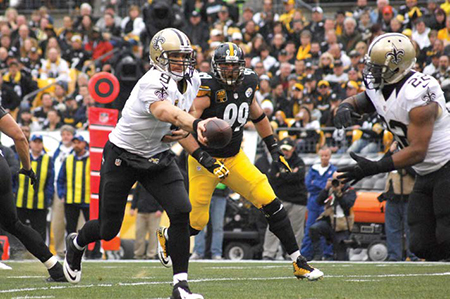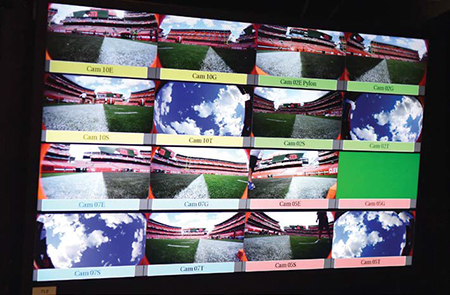Networks Ramp Up New Tech For Football
OTTAWA, ONTARIO—U.S. television networks are taking advantage of advanced video formats, IP-based signal routing, and just-in-time video file transfers to enhance coverage of the NFL and college football season. “Sports coverage is usually at the cutting-edge of TV production technology,” said Ken Aagaard, executive vice president of operations, engineering and production services for CBS Sports. “We tend to lead the charge into new ways of doing things, on behalf of all our networks’ production and operations facilities.”

Drew Brees (#9) during the Pittsburgh Steelers vs. New Orleans Saints matchup in Pittsburgh last season. The NFL kicks off the 2015 season with the Steelers visiting Gillette Stadium to take on Super Bowl champions New England Patriots.4K AND BEYOND
Although fans can’t view the action in ultra-high definition yet, 4K cameras have become a staple of sports coverage. “This will be our fourth or even fifth year that we’ve used 4K equipment in some area of football coverage,” said Michael Davies, senior vice president of Fox Sports’ Media Group Field and Technical Operations. “4K cameras are extremely useful for capturing high-resolution footage that we can then digitally zoom into for HD replays and slow motion clips.”
The Sony HDC-4300 variable frame rate camera is the preferred choice for NFL and college football coverage with at least three of the four networks (ESPN/ABC, CBS and Fox) using the camera system in their mobile football units. Fox is also shooting with the Grass Valley LDK 86 4K and Vision Research v642 2K cameras to shoot slow motion clips.
“The v642 provides higher resolution than HD, variable frame rate, and the ability to work over a single server channel on our Game Creek Encore mobile production unit,” said Davies. “In contrast, the HDC-4300 at full 8x slow-mo requires nine channels.” Fox is adding Vision Research Phantom Flex4K cameras to its football roster to broaden its base of 4K camera options. The Flex4K can shoot 4K footage at speeds up to 1,000 frames per second.
When it comes to using advanced video formats to cover football, ESPN is pushing the envelope this fall, including the testing of the “Pylon Cam,” a custom-molded goal line pylon that houses multiple cameras that can bring new imaging perspectives around the goal line during the game. ESPN has consulted with the NFL on the development of the Pylon Cam since it debuted the device during the College Football Playoff Championship in January. The network tested it during this year’s NFL preseason and, depending on feedback, may decide to use it during the Monday Night Football debut on Sept. 14. It also may utilize the Pylon Cam during some college football telecasts this season.

During the NFL preseason, ESPN tested the “Pylon Cam,” a custom-molded goal line pylon that houses multiple cameras that can bring new imaging perspectives around the goal line during the game.

“We’re active in testing, research and development around new video formats, including 4K, 8K, HDR and more,” said Jon Pannaman, vice president of content and production systems for ESPN. “We’ve also got some other new things that we are exploring in terms of using technology to bring new views to consumers, but we’re not in position to talk about those just yet.”
The professional video industry's #1 source for news, trends and product and tech information. Sign up below.
CBS is also trying out new cameras as it deploys its new SSCBS mobile unit to cover football. In addition to SSCBS’ flagship Sony HDC-4300 4K cameras, the network will be testing its own version of pylon-mounted small cameras and 360 degree-cameras on its “Supracam” two-point aerial 4K camera system. “Supracam is strung between two points in the stadium and flown over to the opposite side of the field,” said Aagaard. “This camera just moves in a straight line, always looking down the line of scrimmage. We would possibly place 360-degree cameras on the Supracam system, giving 360-degree camera views.”
IP ROUTING ADDS CAPACITY
Compared to traditional SDI signal routing, IP-based routing can support far more signal channels and connections. This is why Fox’s Encore unit is equipped with an Evertz EXE IP-based router, Evertz 570IPG high-density IP gateways, and an uncompressed 10Gbps Ethernet infrastructure that can carry and switch the equivalent of 6,900 uncompressed HD-SDI signals.
“We are very happy with the extra capacity that IP provides to our Encore unit,” sDavies said. “This unit probably won’t get fully tasked until we cover the Super Bowl.”
CBS Sports is also using hybrid IP and SDI routing in its new NEP-built SSCBS mobile production unit. “CBS is committing to an IP-based infrastructure for video, audio and communications,” said Aagaard. “As these technologies continue to mature we are prepared to take advantage of them.”
Another big trend in this season’s pro/college football coverage is the expanded use of video file transfers. These files are transferred on a “just-in-time” basis to mobile units to broaden their choice of real-time templates and content during live production; and from mobile units to network storage facilities to allow more people to pull and edit highlights quicker than ever before.
ESPN is using off-the-shelf network-attached storage hard drive arrays to create dedicated network-connected data storage centers for football video files. Available in storage sizes from 6 TB to 2 PB, ESPN calls these dedicated data centers “Bristol Advanced Storage Systems” (BASS); Bristol, Conn. being the home of ESPN’s IP-based (DC-2) Digital Center 2. (When it opened last year, DC-2 was the first-large scale Ethernet/IP-based production facility in the world. It is built around a large Ethernet core of two custom-made Evertz systems that provide 2304x10 Gbps ports, enabling a fully redundant dual path platform with 46Tbps of bandwidth.)
“With all of our football video being directed into a dedicated BASS, our people now have a one-stop-shop for storing, accessing, editing, and playing out football video,” said Pannaman. “DC-2’s tremendous IP-based capacity is central to our ability to utilize BASS for football production. For instance, the facility has the capacity to route and switch more than 60,000 1080p sources at a time.”
There is no doubt that this year’s network football production is more advanced than ever before. But as advanced as it is now, it will likely become even more sophisticated as the 2015-16 season progresses.
“The things that we are doing at the start of the season may well be different by the end,” said Davies at Fox Sports. “That’s just how quickly production technology progresses in U.S. pro/college football coverage.”
James Careless is an award-winning journalist who has written for TV Technology since the 1990s. He has covered HDTV from the days of the six competing HDTV formats that led to the 1993 Grand Alliance, and onwards through ATSC 3.0 and OTT. He also writes for Radio World, along with other publications in aerospace, defense, public safety, streaming media, plus the amusement park industry for something different.

